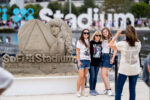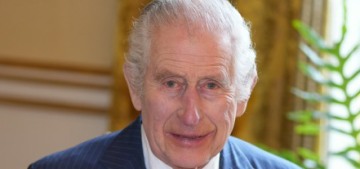Embed from Getty Images
We all knew it was just a matter of time before Taylor Swift started impacting the fields of seismology and geology. Last July a Seattle Eras Tour stop set off enough tremors that the concert showed up on a seismograph. This prompted the California Institute of Technology to put sensors in place at LA’s SoFi Stadium in time for Swift’s August dates for further research into her earth-shattering capabilities, being dubbed “SwiftQuakes.” Was it the instruments? Was it the amps? Was it Swift herself, bearing the voice of a prophetess equal parts lyrical and powerful? Nope, it was all the fans jumping up and down. Here’s more of the science behind the results:
Gabrielle Tepp, author and amateur bass guitarist, said that the harmonics of the “concert tremor” that was recorded look a lot like those from volcanoes or trains, not quakes. They were low frequency and not heard by the human ear. Large music festivals and stadium concerts produce similar vibration signals that resemble a harmonic tremor.
The biggest bang came when Swift sang “Shake It Off.” The tremor was equivalent to about a magnitude 2 quake. Instead of using magnitude, which is energy given off in a moment, scientists measured radiant energy, which is given off over time, for example, during a song. Tepp dubbed it “song strength.”
After conversions done based on an American Geophysical Union study, these are the top five energy-releasing songs from Swift:
1. Shake It Off — about magnitude 1.798.
2. You Belong With Me — about magnitude 1.796.
3. Love Story — about magnitude 1.76.
4. Cruel Summer — about magnitude 1.71.
5. 22 — about magnitude 1.64.“Keep in mind this energy was released over a few minutes compared to a second for an earthquake of that size,” Tepp said in a news release. “Based on the maximum strength of shaking, the strongest tremor was equivalent to a magnitude 2 earthquake.”
She could identify 43 of 45 songs just by looking at the spectrograms — a graph of the strength of various signal frequencies overtime. The other two songs did not register.
“My gut feeling was that if you have a harmonic signal that is nice like these, it had to be from the music or the instruments or something,” Tepp said, admitting that her initial thoughts were wrong.
She was so surprised that she set up her own trial, playing Swift’s music over a PA next to a motion sensor. Then she grabbed her own guitar and rocked out to her own version of “Love Story.” It was not her bass beats that triggered the motion sensor.
“Even though I was not great at staying in the same place, I ended up jumping around in a small circle, like at a concert,” Tepp said. “I was surprised at how clear the signal came out.”
She said bass beats are rounder on the spectrogram, while jumping creates spikes.
Now, imagine the 70,000 Swifties all jumping together to “Shake It Off.”
“The structural response of the stadium showed nearly equal shaking intensifies in the vertical and horizontal directions at frequencies that match the seismic signals recorded outside the stadium,” the study said. “All evidence considered, we interpret the signal source as primarily crowd motion in response to the music.”
Well, duh, I could’ve told you the results would show that “nearly equal shaking intensifies in the vertical and horizontal directions at frequencies that match the seismic signals recorded outside the stadium.” Come on, it’s not rocket science — it’s rock n roll science! (Dad Joke #1.) At the very least, I could’ve told you that a bunch of people jumping has a reaction. I grew up in San Francisco and remember having many earthquake drills in school. My parents even had to pack me an in-case-of-the-apocalypse lunch bag that was kept in the classroom. I peeked inside once and read the note my mother had written on a napkin, with the opening lines: “Dear Kismet, If you’re reading this we are having an earthquake. Either that, or your father is jumping up and down on the bed.”
I hope this study inspires young minds out there to get into science. Just think about it, kids: your job as an adult could be to record the results of you rocking out on a guitar. Or to watch for when the lines on a graph go nuts to different pop songs, thus giving you the intellectual authority to say “‘Shake It Off?’ More like ‘Quake It Off!’” (Dad Joke #2 and I’ll stop now.)
Photos credit: Backgrid, Getty and via Instagram












You have a great Mom.
I do!🧡
This along with the Kate news and memes, I’m sitting here having coffee and uncontrollably giggling. The world has really gone insane, but at least we have some levity 😂
I love this . Kismet you’re awesome.
Doesn’t this occur with just about all large concerts or festivals? Why all this rush to convert Taylor Swift to God-like status? She’s not the only person on earth that has staduim concerts. What happens when the Broncos score a touchdown at their stadium? Silence?
This is not “earth shattering” news (collective Dad Joke #3?) as I’ve been to concerts that made SoFi shake–when BTS played Idol in the Permission to Dance tour you could feel the stadium shaking if you weren’t jumping along. And I’ve seen Taylor a few times and agree that Swifties can probably shake a stadium too.
But it is cool to measure, and I hope they continue to gather data!
There was a study a few years ago about the influence of a nightclub on a seismic measuring station in Japan. It took the a while to figure out while the measured earthquakes every friday saturday night.
There is also a study going on about the long term inpact of a yearly metal fastival in nothern germany. In this case lead by archeologists. ist seems that the monitoring of the long term inpact on the soil (compression, euthropy etc.) can help to interpret the soil changes from old cultural centers. Maybe Stonehenge was only a festival stage 🙂
I meet the researchers at the festival and asked them what they where doing, but can’t remember all the details.
Fascinating!
Lol I live about 10 minutes from the Broncos stadium. (In 12 years it’s been called at least three different names, I am not interested enough to keep up with them.) the fans are…intense. But if anything is causing seismic activity at that place it’s because the stands etc. are made entirely from steel. I personally cannot feel or hear anything from my house, but there are articles about this particular quirk!
Honestly? This is hilarious and awesome. It’s got a real “Beatles fans are screaming” energy